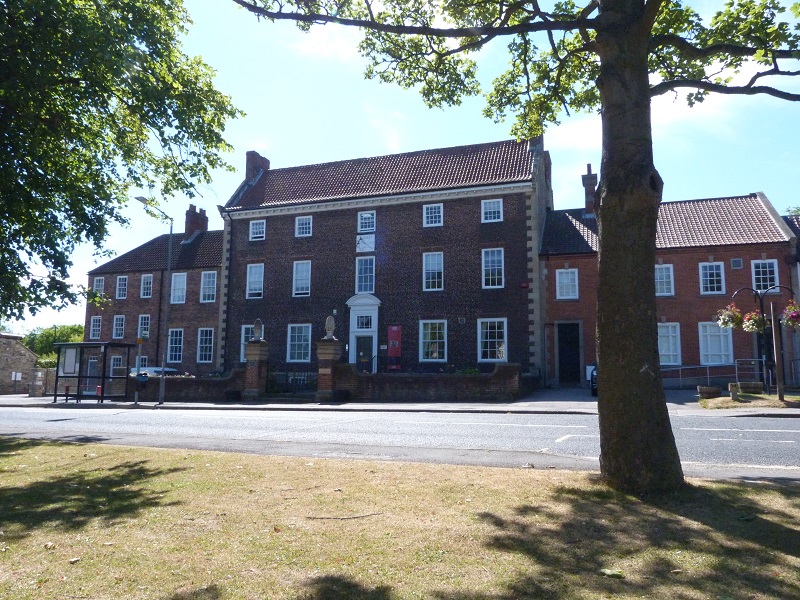|
The Manor House, Sedgefield
The Manor House in Sedgefield, County Durham was built in 1707 on high ground in a country setting looking on to St. Edmund's Church as a mansion house for wealthy judge Robert Wright. Its notoriety arises from the eminence of the judge of Middle Temple who went on to be Chief Justice of colonial South Carolina and also because it is a rare example of Queen Anne style architecture in an area as far north as Sedgefield, with fine and distinctive architectural features including, reportedly, a wood carving by Grinling Gibbons. In 1756 the house was acquired by John Burdon of nearby Hardwick Estate who installed a noteworthy Palladian Venetian window very likely by the architect James Paine. In the twentieth century the Manor House was the head offices of Sedgefield Rural District Council and after that Sedgefield Magistrates' Court. Background The Manor House which is a Grade II* listed building was never in fact a house for the lord of the manor but was built as a mansion hou ... [...More Info...] [...Related Items...] OR: [Wikipedia] [Google] [Baidu] |
Robert Wright (South Carolina Judge)
Robert Wright (1666 – 12 October 1739) was the son of Sir Robert Wright, Chief Justice of the King's Bench (1687–1689) who died in Newgate Prison following the Glorious Revolution. In the same year Robert was called to the bar at Middle Temple and became a judge. Robert took the role of Judge of the Common Pleas in the North East of England and married widowed land-heiress Alicea Pitt (née Johnson) (''d''.1723), daughter of John Johnson of Sedgefield and settled in Sedgefield before returning to London following the Hanoverian succession in 1715. Meanwhile, he fathered seven children with his mistress Isabella (1675 – 21 November 1752) in Bloomsbury, before sailing for colonial Charles Town to become Chief Justice of the colony of Carolina, and subsequently South Carolina, and a plantation owner. He died there in 1739. His son Sir James Wright went on to become a colonial governor of Georgia. Biography Born into the wealthy Wright family of Kilverstone in No ... [...More Info...] [...Related Items...] OR: [Wikipedia] [Google] [Baidu] |
The Manor House, Sedgefield
The Manor House in Sedgefield, County Durham was built in 1707 on high ground in a country setting looking on to St. Edmund's Church as a mansion house for wealthy judge Robert Wright. Its notoriety arises from the eminence of the judge of Middle Temple who went on to be Chief Justice of colonial South Carolina and also because it is a rare example of Queen Anne style architecture in an area as far north as Sedgefield, with fine and distinctive architectural features including, reportedly, a wood carving by Grinling Gibbons. In 1756 the house was acquired by John Burdon of nearby Hardwick Estate who installed a noteworthy Palladian Venetian window very likely by the architect James Paine. In the twentieth century the Manor House was the head offices of Sedgefield Rural District Council and after that Sedgefield Magistrates' Court. Background The Manor House which is a Grade II* listed building was never in fact a house for the lord of the manor but was built as a mansion hou ... [...More Info...] [...Related Items...] OR: [Wikipedia] [Google] [Baidu] |
Virtue Radford
Virtue ( la, virtus) is moral excellence. A virtue is a trait or quality that is deemed to be morally good and thus is valued as a foundation of principle and good moral being. In other words, it is a behavior that shows high moral standards: doing what is right and avoiding what is wrong. The opposite of virtue is vice. Other examples of this notion include the concept of merit in Asian traditions as well as '' De'' (Chinese 德). Buddhism's four brahmavihara ("Divine States") can be regarded as virtues in the European sense. Etymology The ancient Romans used the Latin word '' virtus'' (derived from ''vir'', their word for ''man'') to refer to all of the "excellent qualities of men, including physical strength, valorous conduct, and moral rectitude." The French words ''vertu'' and ''virtu'' came from this Latin root. In the 13th century, the word ''virtue'' was "borrowed into English". Ancient Egypt Maat (or Ma'at) was the ancient Egyptian goddess of truth, balance ... [...More Info...] [...Related Items...] OR: [Wikipedia] [Google] [Baidu] |


